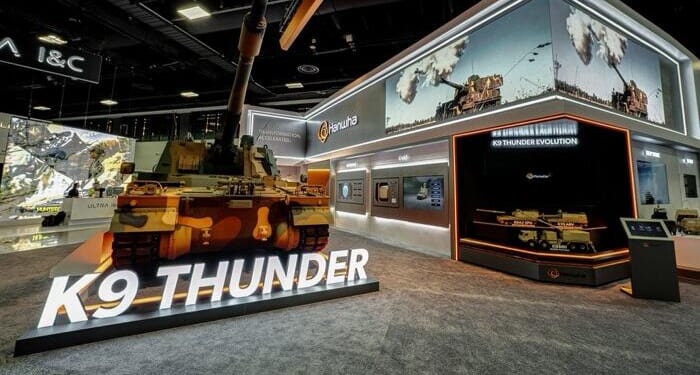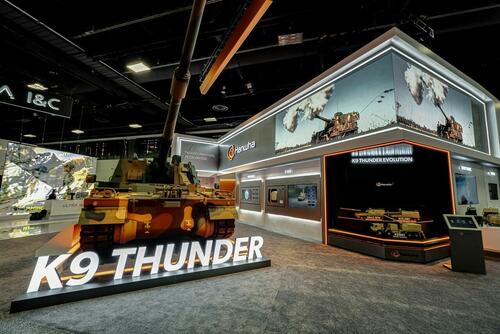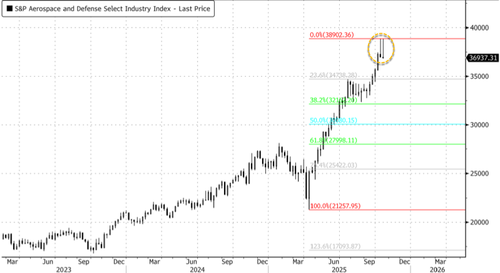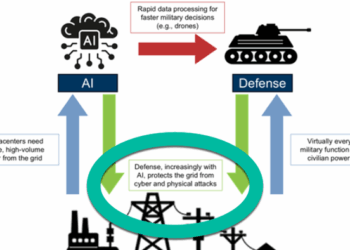The S&P 500 Aerospace & Defense Index (SPSIAD Index) has surged as much as 72% since late March, fueled by rising defense spending and the U.S. military’s strategic reposturing under what we’ve dubbed the “Western Hemispheric Defense” theme. But after weeks of hitting technical resistance, and with growing risks of a near-term pullback, attention now turns to insights from Goldman analysts, who met this week with 15 defense firms at the AUSA conference to gauge what 2026 might bring for the sector.
Two weekly bearish shooting star candles have printed, signaling exhaustion – or at least near-term resistance – and suggesting rising odds of a retracement.
To capture executive sentiment across the defense sector, Goldman analysts led by Noah Poponak met with 15 companies, including large-, mid-, and small-cap defense firms, defense-tech players, startups, and government IT contractors.
Macro Outlook:
Poponak sees the U.S. defense budget rising in FY27 versus the FY26 base, though not when adjusted for reconciliation. International demand for weaponry remains solid but races production capacity constraints. Margin outlooks are mixed.
Defense Tech Momentum:
New entrants are rapidly gaining traction with scalable, advanced technologies, signaling a potential shift in the defense market. Booth traffic at the AUSA conference for these companies was notably high. Legacy defense firms in the drone and space segments are also showing strong growth tailwinds.
AUSA Conference Trend:
A major theme of the conference was counter-drone technology, with many companies unveiling new systems.
Government IT:
Government IT contractors continue to face headwinds from federal personnel turnover and constrained agency budgets, compounded by potential government shutdown risk.
Out of the 15 meetings the analysts held with defense firms, we’re focusing on just two: L3Harris Technologies Inc. and Palmer Luckey’s Anduril Industries Inc.
L3Harris Technologies Inc. (LHX; Buy)
We hosted a group meeting with Bob Daminski (Director, DoD tactical communications). The discussion focused on LHX’s expansion into unmanned systems with differentiated radio technology, robust international radio growth, and new program wins via strategic partnerships.
-
Expansion in unmanned systems and drones: LHX highlighted a push into the unmanned systems market, developing both kinetic and electronic warfare (EW) capabilities, exemplified by their “Red Wolf” and “Green Wolf” initiatives. These are reportedly targeting multiple Army programs, including the “Army Launch Effects” program, with management noting strong customer reception. The company noted its differentiated radio technology for command and control links in these systems, enabling both remote and autonomous operations. LHX also stated it is actively working with partners like AeroVironment (AVAV) to integrate its radios into unmanned platforms.
-
International growth and resilient communication solutions: LHX highlighted strong international growth, particularly in its radio segment, with large orders from countries such as the Netherlands, Poland, and the Czech Republic. This growth is driven by customer demand for security and resiliency in communication, with LHX’s software-defined radios allowing for substantial upgrade work beyond new unit sales. The Company’s TACCOM (Tactical Communications) offerings, including anti-jamming capabilities and the NGC2 cloud network, are key differentiators.
-
Strategic partnerships driving new program wins and market expansion: The Company noted its collaboration with Anduril on projects like Eagle Eye, leveraging Anduril’s expertise in night vision, and the SMBC program of record for next-gen IBAS (Integrated Battle Command System), which Anduril acquired from Microsoft. Domestically, LHX is collaborating with GM Defense on the Infantry Squad Vehicle. These partnerships demonstrate LHX’s ability to integrate its advanced technologies into major defense initiatives and expand its reach into new platforms and capabilities.
Anduril Industries Inc. (private)
We hosted a group meeting with Christian Brose (Chief Strategy Officer) and Allison Lazarus (Head of Investor Relations). The company discussed the state of the defense supply chain, government procurement process, and Anduril’s longer term product and market vision.
-
Supply chain. Anduril noted that progress in the defense space has largely been limited by the supply chain and production capacity rather than funding. The company is building its own supply chain to solve for this issue, with a focus on commercial materials that simplify the supply chain and make it easier to find employees. Anduril has started onboarding employees at the company’s new facility in Ohio that will be 4-5mn sq ft and has access to two twelve-thousand foot runways, and the facility will start opening in 1Q26. Anduril aims to differentiate its production with more automation and larger production batches, along with bringing components causing bottlenecks in-house to enable faster production. Motors are a key area that it has brought in-house and the company noted it can produce 6-8 thousand GMLRS sized motors a year.
-
Shifting government procurement. Anduril emphasized that it does not see expensive exquisite systems going away, but rather being augmented with higher volumes of cheaper, effective systems. The company highlighted that government procurement is moving in this direction as the customer becomes more open to different business models like Anduril’s that are more commercial and rely on IRAD. Additionally, Anduril plans to continue to push for novel approaches such weapons or compute/encryption as a service.
-
Long term vision. The company is being built on a foundational vision of a data fabric and network layer to move information to people and machines efficiently without additional manpower or higher costs. This enables a modular approach that should simplify production and operation of its products. Anduril emphasized that there is not a lack of capable technology to achieve this, rather it is a matter of utilizing up to date systems rather than outdated tech. The company also noted that it embraces partnerships when other companies do things it cannot do internally, and that the team approach with partners like Microsoft and Palantir are novel and more efficient than bringing everything in-house.
Related:
A reversal in stocks only takes a trade headline or two…
Loading recommendations…



















